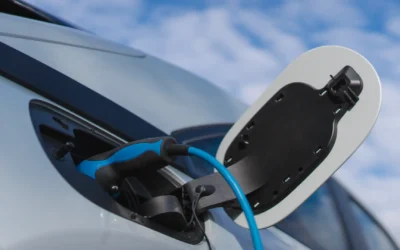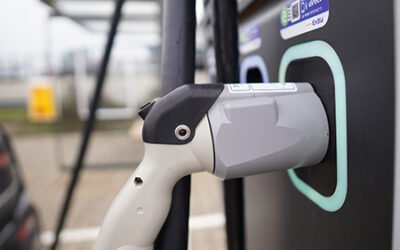- Wireless Charging is still in a budding phase; however, in the long run the EV charging industry will certainly be on an outlook for new innovative approaches to counter the challenges that will arise with EV charging at higher utilization across the globe.
- Countries like South Korea are on the forefront of EV charging, with Genesis GV60, become the first commercially available car to be charging using a wireless charging Technology.
The EV adoption rate is gaining momentum across the globe, driven by emission regulations in Europe and China as well as decarbonization targets in countries such as Norway, the UK, and Germany. With the demand of EVs rising, a challenge that could potentially arise is how to charge the increasing number of vehicles without burdening the grid past its capacity. There are some solutions that hamper the overload on the power grid such as vehicle-to-grid (V2G) integration and Wireless Charging. While wireless charging is currently in the nascent phase, it has immense potential in the market since “short-cut” technologies such as induction charging may encourage more consumers to switch to EVs.
Mechanism for Wireless Charging
Wireless EV charging can be the real game-changer in the E-mobility sector since it does not require an interface or any supplementary equipment like cables for EV recharging. The only thing required is the EV charger development which involves installing induction pads beneath parking stations, homes, offices, drive-throughs, and supermarkets. The charge pads have an oscillating magnetic field picked up at the same frequency as the vehicle’s receptor. As a result, the battery’s charging process starts instantly and stops when the battery achieves a full charge.
The driving objective of wireless charger technologies is to enable EVs to charge in under 10 minutes. As a result, this could be the shortest time taken to charge an EV in history. However, there are some impediments since high amounts of power are required.
To address the concern of the lack of a charging infrastructure presently, many countries are exploring other viable options such as wireless or in-motion charging. Some posit that wireless EV charging will pose an additional strain on the existing power grid infrastructure by increasing demand variability due to the fragmented charging duration caused by charging lane layouts and traffic.
On the other hand, many argue that wireless charging decreases the demand on the power grid as energy demand is spread over time and space throughout the day, rather than being confined to stationary chargers’ charging periods between 2 p.m. and 7 p.m., thereby enabling a reduction in the required power grid connections and upgrades.
Current Potential of Wireless EV Charging and How it’s Paving Way into the Market
Wireless charging can be deployed in locations where plug-in charging solutions are not viable such as roads, taxi queues, bus stations, and terminals. Therefore, wireless technologies can charge EVs at regular intervals throughout the day and ensure more efficient and stable utilization of energy.
In Scotland, there is a Wireless Charging project underway of GBP £1.6 million led by the software and technology company Flexible Power Systems in partnership with The City of Edinburgh Council. The vans of the fleet will be fitted with a slim charging pad on their underside and will charge in under an hour by parking above electric pads. Similarly, in Norway, there are 25 Jaguar I-Pace taxis that recharge wirelessly on a taxi rank embedded with charging pads. It’s becoming increasingly evident that this energy efficient solution may prove pivotal for electric fleets since they have dependable routes and waiting places. Another company based in US called Plugless Power is working on its third-generation inductive EV charger which will be released in 2022 and will cost approximately USD $3500 plus installation. These chargers are designed to work with a US domestic 240V output and fit in to existing cars.
South Korean automakers are clear global leaders in the effort to introduce EVs with wireless charging. WiTricity is the global industry leader in wireless charging with its patented magnetic resonance technology being developed to support wide-scale adoption. In October, they recently entered into licensing and technology transfer agreements with Green Power, a leading South Korea-based supplier of power electronics and high-power wireless charging systems for various applications. The agreements allow Green Power to leverage WiTricity’s innovative technology and reference designs for wireless EV charging systems. WiTricity announced that its patented technology will have its first availability as factory-installed equipment in a fully electric vehicle for Genesis on the new GV60 EV. The optional inductive charger will refill the SUV’s 77.4kWh battery more quickly than a typical home plug-in charger.
Looking Forward
Amidst increasing concerns about an outdated or incompatible power grid infrastructure in the face of widespread transport electrification efforts, innovative charging methods can prove to be a monumental solution. Although wireless charging is still in its budding phase, the pros clearly outweigh the cons. It is imperative that the EV charging energy is evenly distributed throughout the day to avoid overloads and, thus, technologies such as wireless charging will become critical resources in adapting to an all-electric decarbonized future.
EV Charging Infrastructure Service Overview
The research presented in this article is from PTR's EV Charging Infrastructure market research. For information about this service please submit a request shown below.
Contact Sales:
More about our:
EV Charging Infrastructure Market Research
Recent Insights
Sustainability Across Sectors: Highlights from GreenTech Festival 2024
Recently, I had the privilege to attend and present at the Greentech Festival, an excellent event in the realm of sustainability. This influential...
An Evolving Market: Rise of Electric Vehicles in Europe (2023)
This infographic examines the electric vehicle (EV) market in the European region. It highlights the current and forecasted EV market size of each...
Evolution of V2G: CPOs-Automotive OEMs-Utilities at the center of transition
Evolution of V2G: CPOs-Automotive OEMs-Utilities at the center of transition [ba_advanced_divider active_element="text" title="About the Whitepaper"...


